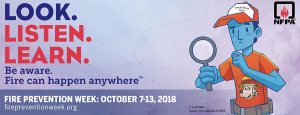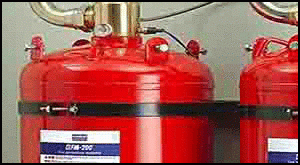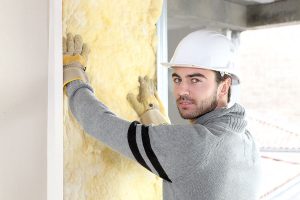Posts by Test
How Visual Cues Help In Fire Safety

Visual communication has become a proven and worldwide famous tool for the workplace's safety in fire hazards. The tool helps employees understand all essential safety measures and practice them at the workplace to ensure the vicinity's safety that provides the facility's safety and improves the employees' emergency response at the time of emergency.
Employees should attend safety training in visual communication tools. If the employees are not trained on the visual signals, they won't follow the visual signals in case of any emergency, leading to a disaster. To effectively implement these visual signals at the workplace, the employees must know what they mean and how to use them. The effective use of visual communication will help the organization create better workplace safety and standardization of 5S at all levels.
Examples of Fire Safety
There are different forms of visual communication companies can use for workplace safety. Wall signs are the most important type of visual communication. These signs are primarily used for fire safety and to alert people to use emergency exits. These signs help people identify necessary safety equipment like fire extinguishers and PPE or any other available equipment at the facility. Wall signs are proven useful against fire safety as they are easy to approach, eye-catching due to their contrasting colors, mostly having red text with white background to make anyone alert.
Companies can use floor markings as another tool of visual communication for the fire safety of their facility. Floor markings can include signs like fire extinguishers, electrical panels, and potentially dangerous areas identification using the red floor tape. Floor markings are more useful than wall signs because they can cover more area and give a complete track to follow in an emergency. For floor markings, the use of tape markings is quite useful to chalk out plans for emergency response, particularly the use of glow-in-dark tapes. This type of tape is used to mark emergency exits and set a pathway to follow in a power failure.
Machine and pipe labeling is another type of visual communication that ensures fire safety concerning devices and pipelines. However, it is quite dull but essential to mark all the machines and pipes in a factory or manufacturing unit to prevent potential fire hazards. Every device must carry labels conveying the information on how to use it and what safety equipment to use for operating a particular machine. Especially machines used for welding/cutting must be handled with care using the safety equipment as they can result in fire eruption. Similarly, pipelines carrying potentially dangerous gases and liquids must-have a label on them for compliance with ANSI and OSHA regulations and prevent employees from accessing or opening them without SOPs. It will help employees to report any spilling or leakage to the emergency teams.
Employees and Management can make the workplace safe if they are appropriately trained in using the different forms of visual communication that can help prevent fire hazards.
Is NFPA 25 Mandatory

Complying with NFPA 25 is mandatory for businesses to ensure their fire protection systems operate optimally and avoid hefty penalties upon violating the code.
NFPA 25 is a globally recognized compliance baseline for inspection, testing, and maintenance (ITM) of water-based fire suppression systems. This standard's objective is to verify the integrity and efficacy of the systems and ensure they operate optimally in case of a fire breakout. It specifies the minimal care and amount of work required to maintain the systems. In the US, this standard has been adopted in most states through either the building code or the fire code.
What is the Importance of NFPA 25?
Once you install a system, the NFPA 25 standard provides a suggested timeline and frequency to conduct specific requirements - Inspection, Testing, and Maintenace.
Inspection: A meticulous examination of the system to detect physical damages and signs of corrosion, deep dents, or any other flaw.
Testing: A physical testing of the system ensures it withstands immense pressure during operation and has no leakage.
Maintenance: Experts perform jobs to repair or maintain the system, like replacing disposable components or reinstalling the hose and tamper seal.
It is mandatory to conduct ITM monthly, quarterly, or annually. According to NFPA 25, the property owner or designated representative is accountable for the fire protection system's overall maintenance. During monthly inspection, the on-site fire protection person should examine the pipe system gauges, ensure water pressure maintenance, and inspect the alarm valves.
However, you must outsource quarterly and annual ITM services to licensed fire protection experts. They will determine the facility's safety by identifying areas or processes that could jeopardize people or property during a fire breakout. In case hazardous conditions are determined to exist, recommendations will be made to fix the issues in a reasonable time frame. Thus, you will ultimately take your facility's safety to the next level while complying with the NFPA 25.
You are also advised to retain all the recent inspections and test records and be prepared to show them to the service provider when requested. Keeping these inspections up-to-date will help you avoid fire protection system failures and code violations.
NFPA 25 Inspection – Things to Keep in Mind
Preparing for an NFPA 25 inspection can be stressful if it's your first time. This is especially true for premises that have gone through significant remodeling and require a completely new look at their safety systems. While it's not always a mandatory part of running any property, it's a good idea to follow the guidelines laid out in the regulation as closely as possible. This can not only save lives if something eventually goes wrong, but it can also contribute positively to your bottom line in terms of time and money invested in the maintenance of your buildings.
Is an NFPA 25 Inspection Mandatory?
The NFPA 25 inspection standard is just that – a standard. It's not a legal regulation that dictates how often your premises should be inspected, contrary to what some believe. However, it may still be mandated on a local level through various laws and regulations, and it's essential to pay attention to those if you want to ensure that you're compliant. Check your local building codes, get a consultation with a specialist – or even submit an inquiry to the fire marshal, depending on how these regulations are structured in your region. But as we mentioned above, it's a good idea to submit your premises for an NFPA 25 inspection regularly, even when it's not a strict legal requirement.
How Frequently Do I Need to Have My Systems Inspected?
NFPA 25 provides various suggested inspection frequencies for the different components of your fire suppression system. Many elements can be checked quarterly or even annually – such as pipes and fittings, sprinklers, spare emergency sprinklers, and more. However, others require a much more systematic approach, such as control valves (which have to be checked weekly or monthly depending on their type). Your sprinklers will typically have to be sample-tested every five years, and there are also 10- and 20-year testing periods for different types of sprinkler systems. Some system components depend on their manufacturer's guidelines for their testing frequency, so you'll have to consult them to ensure that you're compliant.
NFPA 25 Testing Requirements
Standard for the Inspection, Testing, and Maintenance of Water-Based Fire Protection Systems
NFPA 25 is the baseline for inspection, testing, and maintenance of water-based fire protection systems. Compliance helps maximize system integrity to avoid failure and ensure fast, effective response in a fire emergency.
Usually, only parts of a system must be tested to validate the fundamental component for passing the inspection. For example, with sprinklers, you're generally required to test around 1% of the ones connected to a specific system. However, the number must not be less than four. You should consult with an inspection specialist to ensure that you're not missing any important details, which is a real risk when it comes to something as complicated as an NFPA 25 inspection. There are also specific requirements that might prompt further inspection – such as the presence of corrosion on certain elements. Leaks should be reported before the inspection so that additional attention can be paid to their area.
How do I prepare for a fire inspection?
It isn't much you should do specifically to get things ready for an NFPA 25 inspection other than to do a rudimentary check on your sprinklers, valves, and pipes to ensure that there are no obvious signs of corrosion or leaks. If you are dry-testing individual components, make sure that you know where the shutoff valve is. Sometimes you may need to kill the flow in advance to ensure that the system will be in a proper condition for testing when it comes. If in doubt, consult a specialist in advance to be sure that everything will be prepared adequately.
It's a good idea to take notes during the inspection to ensure that you'll be better prepared in the future. This is the kind of process where you can benefit from prior knowledge, even when you support a dedicated specialist assisting you through it. Don't leave any doubts hanging in the air either, because it's better to resolve those questions well in advance rather than finding out that you have to modify the test – or postpone it all together – in the middle of the whole ordeal. When done right, this is a relatively hassle-free process that will ensure that everything is in order with your building in the long term when it comes to fire safety.
Final Words
Fire protection systems minimize the risk of damage and loss of lives by quenching fire within seconds. These systems suffer wear and tear issues like any other building system. The regular, timely inspection and testing of the fire protection systems as per NFPA 25 will ensure that they are optimal and provide your facility with an extra protection level.
Additionally, NFPA 25 is regularly being enforced by the fire department of Orange County. So you must perform mandated inspections to avoid any violations and save yourself from hefty penalties.
What Types of Fire Sprinkler Heads Can You Use in Your Restaurant Fire Suppression System?

Understanding the differences between the various types of fire sprinkler heads available on the fire suppression market is crucial to ensure that you're investing in the best possible system. There aren't that many options to pick from, and all of them are relatively popular. You may see all four fire protection sprinkler heads often in your everyday life but have just not been paying attention to what types of fire sprinkler heads you can use in your Restaurant Fire Suppression System until now. Let's look at what's available and what each type of head is appropriate for.
Pendant Fire Sprinkler Head
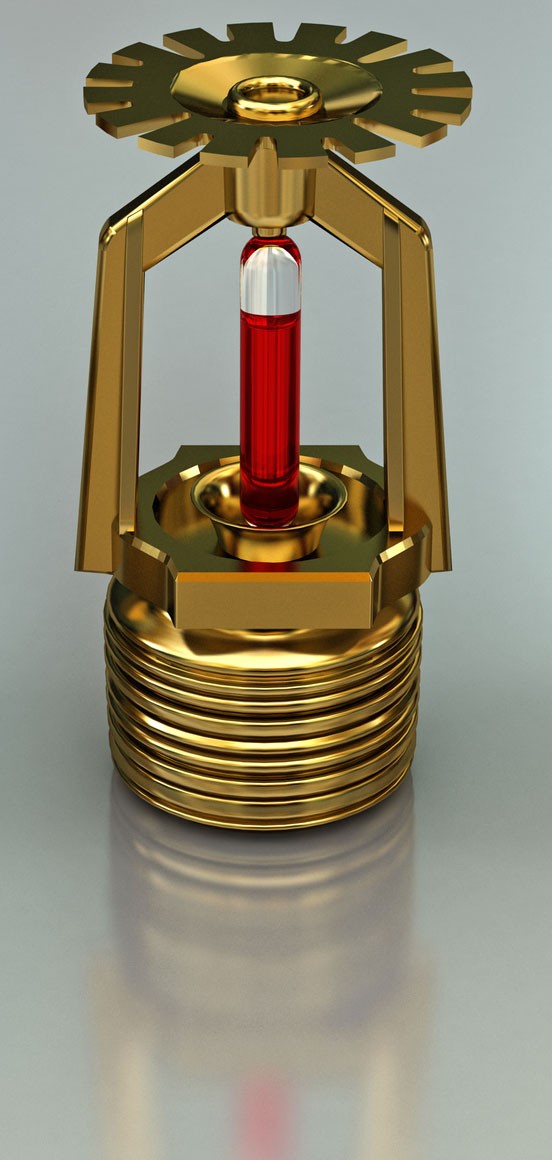
This is the one that you'll likely see most often in commercial buildings and other similar environments. A pendant fire sprinkler head is shaped in a circle and hangs from the ceiling. It sprays water downwards, hitting a specially curved plate at the bottom of the sprinkler. This causes the water to spray in a conical shape centered around the fire sprinkler head, effectively covering a large part of the area consistently. The plate has tiny gaps in it to create the spraying effect, and its exact angle may vary from one design to another. The general principle is always the same, though. Pendant fire sprinkler heads are valued for their utility. You can use Pendant fire sprinkler heads in various environments where fire suppression coverage requirements are for a large area with a short coverage time is the primary concern.
Upright Fire Sprinkler Head
An upright fire sprinkler head functions similarly to a pendant, but it's inverted vertically. The sprinkler is placed at a low location (typically on the floor or close to it), pointing upwards. The deflector plate sits on top of the sprinkler and accomplishes the same effect as in a pendant fire sprinkler, forcing water to spray in a circular pattern around the device. Upright fire sprinklers have several applications, and they are commonly found in environments with a more complicated layout, where covering the entire area from above may be an issue. They are often found in industrial settings, where overhanging machinery can pose a problem for pendant fire sprinklers, blocking them partially (or even fully) and limiting their effectiveness. Buildings without a roof also typically rely on upright sprinklers.
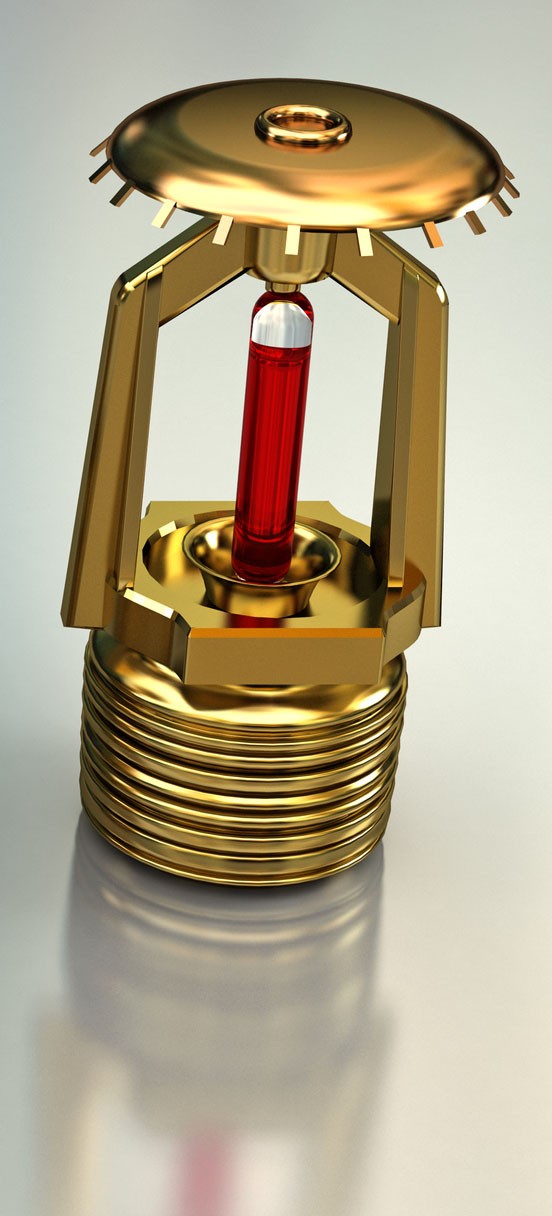
Sidewall Fire Sprinkler Head
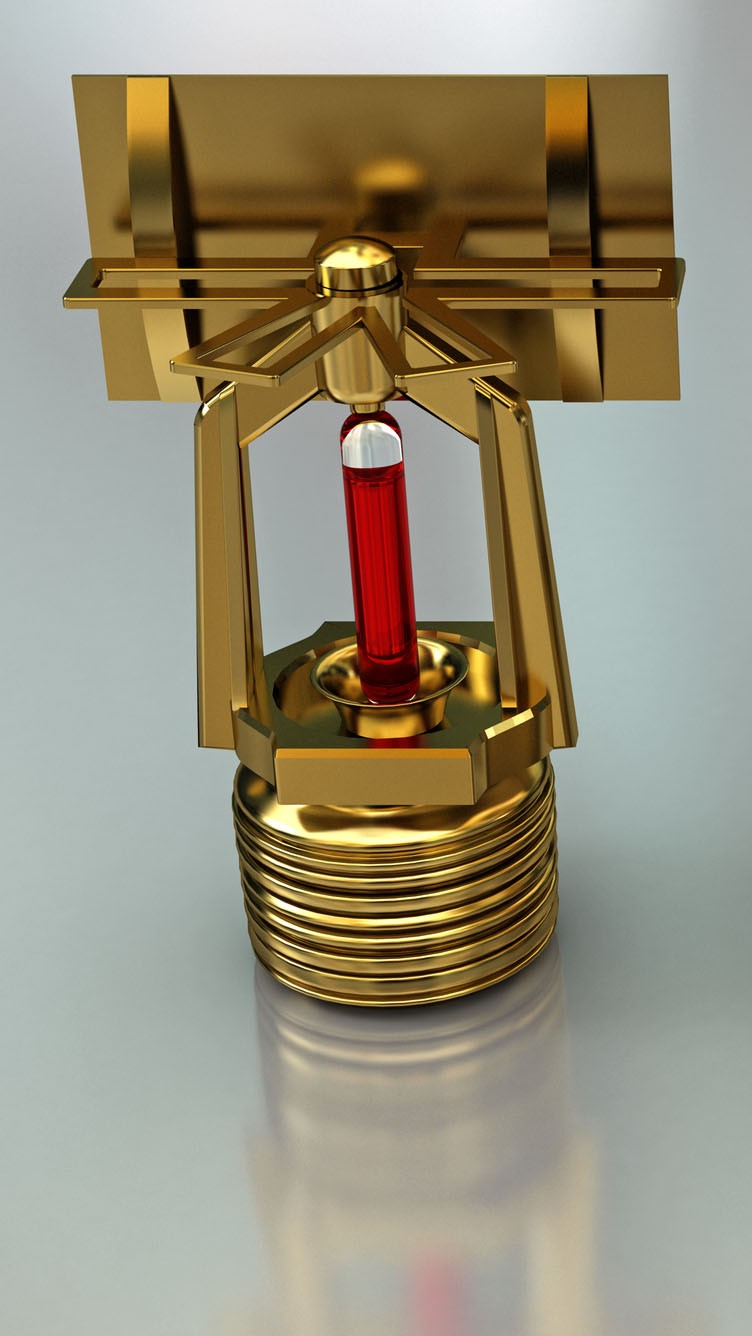
A sidewall fire sprinkler head is mounted vertically, typically on a wall. It works similarly to the above designs, but the deflector plate is shaped differently to point the water spray in a specific direction – typically downwards. This means that a sidewall sprinkler will usually not spray in a full circle around itself – which may sound like a limiting factor. Still, it's desired behavior in environments where space is limited, and a typical ceiling-mounted fire sprinkler will not be sufficient. Sidewall sprinkler heads are also frequently used to circumvent obstructions in places where an upright fire sprinkler will not get the job done correctly and in tighter environments.
Concealed Pendent Fire Sprinkler Head
Concealed pendant fire sprinkler heads are similar in their overall design to pendant sprinklers. Still, with one significant difference, they are specifically designed to blend into the environment more efficiently, avoiding any aesthetic disturbances. This is typically achieved by integrating the sprinkler into the ceiling itself, with a plate covering its bottom that blends with the ceiling's design, concealing the device. The plate is designed to fall automatically when a certain temperature threshold is reached. To ensure proper, unobstructed operation of the fire sprinkler, that threshold is typically below the activation temperature of the sprinkler itself. That way, there is some delay between the plate falling, and the sprinkler activates.
Majestic Fire Protection serves many companies with complex buildings designs that require multiple types of fire sprinkler systems, fire sprinkler heads to be installed. This method of multiple systems design ensures proper coverage of more complicated areas. In some cases, numerous sprinklers of different types may even be deployed in the same room. This is common in environments with heavy machinery and other factors that restrict the spreading of water from the fire protection system. Plumbing can be a significant challenge when installing complicated fire sprinkler systems services. The existing conditions may not facilitate all designs equally well, so an alternative approach may be required. Well, I hope this article has helped you in your decision process for What Types of Fire Sprinkler Heads Can You Use in Your Restaurant Fire Suppression System.
Fire prevention 101: The basics on restaurant fire safety. (2017). Retrieved December 14, 2020, from https://www.restaurant.org/articles/operations/fire-prevention-basics-on-restaurant-fire-safety
Campbell, R. (2020, December 12). Structure Fires in Eating and Drinking Establishments. Retrieved February 14, 2017, from https://www.nfpa.org/News-and-Research/Data-research-and-tools/Building-and-Life-Safety/Eating-and-drinking-establishments
Reasons why your water bill is high & You need Leak Detection
Most people complain that although they don’t use water in their homes so much, their bills are usually high. Some times they even suspect water leak. This is a growing problem and hence, there is a growing need to critically analyze why this happens, and what measures can be taken to ensure your bill is low, according to your hopes and expectations.
Final Thoughts
If you want your water bill to be reasonable, it would be a good option to start from where you have the most control: personal habits. Bad habits are the major cause of high water-bills. Once you have ensured that you do not waste, then you may take other incentives that you have an even lesser control over.
Do you need a Fire Sprinkler System in your Home?
A fire sprinkler is a water system that automatically detects dangerous levels of fire in an enclosed area and sprays water through a sprinkler on a large range of areas to put down the fire. The sprinkler is usually attached at the ceiling in the middle of the room to cover maximum spread as evenly as possible. In this article is discussed why Fire Sprinkler systems should be installed at homes.
If you need some professional assistance to install Fire Sprinkler at your home you can contact us anytime.
Why are they needed at home?
Fire sprinkler systems are usually installed in commercial buildings and offices. Houses have little to no initiatives to prevent fires in most cases. At best, people may own a fire extinguisher in their homes to put out fire when the need arises. However, experts are suggesting that Fire Sprinklers are important for residential houses too. In fact, they hold benefits above many other precautionary means.
Final Thoughts
Having Fire Sprinklers installed in the home would be beneficial in the long run. It will ensure safety, given its effectiveness and timely response. Since they are released only in areas where there is a treat of fire, it won’t affect the rest of your house, being more cost friendly, efficient, and precise. It is best to stop relying on manual methods and go completely automatic.
We are here to offer you our professional services anytime. Contact us now and we will be at your door steps to help you as soon as possible.
Fire Prevention Week 2020
National Fire Prevention Week 2018

Fires can be extremely scary, in seconds you can lose almost everything. Knowing what to do when an emergency occurs is crucial to your safety and is why the National Fire Protection Association created Fire Prevention Week some time ago. In 1925 the great Chicago fire destroyed homes and even took lives. In commemoration of those who were lost, this week is now a way to educate and further spread awareness about fire prevention to the surrounding community. Because fires are unpredictable and can spark at any time it is important that all members of your family are properly informed on how to stay safe. Safety is what matters most!
This year’s campaign initiative is “Look, Listen, and Learn. Be aware. Fire can happen anywhere”. Look for places a fire could start and make sure that all things that be potential “fire starters” are taken care of. Items such as lit candles, built up dryer lint, and loose lighters are household items that are usually overlooked but are extreme fire starters. Next make sure to Listen for an alarm. Fires do not have a clock and can start anytime anywhere so to ensure you are ready designate a meeting area that is far enough from the potential flames and get out as quickly as possible. Finally is the learning aspect of it all. Whether you are in school or not it is important to learn your surroundings. No matter where you are, make sure to designate 2 forms of exit should a flame start.
Thankfully technology makes everything easier and so does the NFPA. Using printable information cards, online videos, and Sparky the Fire dog of course, the NFPA has made celebrating this week of knowledge fun and easy. There’s no need to look any further with their many resources. If you are looking for an even better experience of this national celebration, many local fire departments will be participating in this initiative as well. By visiting schools, allowing for fire prevention seminars, and even cookouts the options are endless. Make sure that you research your local fire department to see if there are any events you can be a part of. For more information about Fire Prevention Week and to learn how you can prevent any of your own fires visit nfpa.org.
Why Should I Choose an FM-200 Suppression System?
Why Should I Choose an FM-200 Suppression System?
If you’ve done some research into fire suppression and the most effective methods of fire suppression, you’ve probably run across FM-200 fire suppression systems. Although traditional fire sprinkler systems are still used in many residential and business buildings, a waterless option can result in less cleanup and a more efficient suppression. Here are some of the most obvious benefits of using an FM-200 suppression system as your fire suppression system of choice.
Waterless and Clean
Water-based suppression systems are a great choice for some homes and businesses but can leave the entire fire area dripping wet. Electronics and paper products can be ruined, or it may just make for some tedious and potentially expensive cleanup. The FM-200 suppression system, on the other hand, is completely waterless and doesn’t result in those kinds of consequences. In addition, with the California drought, using a fire sprinkler system may be extremely expensive, especially for large business clients in Los Angeles, and some municipalities may have limits on the amount of water your business can use in a certain time period without incurring fines or other punishments. With an FM-200 fire suppression system, you won’t have to worry about that.

Some fire extinguishing systems use carbon dioxide or certain chemicals to smother the fire. While by themselves these are usually non-toxic if used in certain ways they can be extremely dangerous. Triggering a carbon dioxide extinguisher in a small, enclosed space can cause a lack of oxygen, and some people may react poorly to even non-toxic chemicals in fire extinguishers. FM-200 is formed of carbon, fluorine, and hydrogen, all of which are extremely common chemicals and are highly unlikely to cause a reaction in anyone. The most potentially dangerous side effect is that skin contact with the liquid, which is very rare, can cause frostbite.

Extremely Easy to Clean Up
No matter what type of fire extinguisher that’s used, whether it’s water, chemicals, or foam, there is going to be some cleanup required after the fact. Much of the time, this cleanup is as taxing as the actual fire and can take multiple hours. However, the FM-200 fire suppression system discharges within 10 seconds, then leaves absolutely no residue. It’s gained worldwide acceptance and been installed over 100,000 times, and it’s likely that it’s a great idea for you and for your business.

Saving Energy Around the Home – What is the Best Type of Insulation?

Saving Energy Around the Home – What is the Best Type of Insulation?
You probably already know that adding insulation to your home is one of the best ways to lower your utility bills and save money. Installing additional insulation in your attic and in your walls can keep the warm air in during the winter and the cool air in during the warmest days of summer.
What you may not know is what kind of insulation is best for each installation. Every home is different, and it is important to match the type of insulation to the specific needs of the room.
Rolls and Batts
Rolls and batts are often referred to as insulation blankets. These insulation blankets are flexible and constructed from mineral fibers like rock wool and fiberglass. This is among the easiest type of insulation to install, since it is available in widths that match the standard spacing between wall studs and floor joists.
That standard size makes this type of insulation an excellent choice for the attic. Choose R-13 or R-15 batts for a 2 x 4 inch walls. R-19 or R-21 insulation products are the best choices for 2 x 6 inch walls.
Loose Fill Insulation
Loose fill insulation is typically made of rock wool, cellulose, fiberglass or fiber pellets. This type of insulation is the perfect choice for those hard to reach areas. Loose fill insulation can be blown into spaces that need to be filled. Special pneumatic equipment is used to blow the insulation into place.
Loose fill insulation is often used to insulate around wires, pipes and ducts. It also conforms well to non-standard sized building cavities, and it is often used in older homes to fill in the gaps left by the original builders.
Rigid Foam Insulation
Rigid foam insulation is often used to sheathe exterior and interior walls and to shore up basement walls. Rigid foam insulation is generally more costly than both loose fill and rolls and batts, but it can be very effective.
This type of insulation is available in a wide variety of R-values – from R-4 to R-6.5 per inch. This is more than twice as much as most foam in place insulation styles.
Foam in Place Insulation
Foam in place insulation can be a good choice for insulating under floors, along walls and on attic surfaces. Like loose fill, foam in place insulation can be blown into place to prevent air leakage and the associated energy loss.
Foam in place insulation often comes in special pressurized cans that can be used to seal holes and cracks around window and door frames and to reduce air leakage where electric wires and plumbing fixtures enter the home.
There are actually two different types of foam in place insulation – closed cell and open cell. Both closed cell and open cell are constructed of polyurethane. Closed cell foam uses high density cells filled with gas that allows the foam to expand and fill the space around it. The most effective closed cell insulation has an R-value of about R-6.2 per inch.
Open cell foam cell insulation is not as dense. This type of insulation is filled with air, giving the insulation a spongy texture. The best open cell foam in place insulation will have an R-value of about R-3.7 per inch.
Choosing between open cell and closed cell insulation will depend on a number of factors, including how you plan to? use it and your insulation budget. Closed cell foam in place insulation has a higher R-value and has better protection against air leakage and moisture. Open cell insulation is less expensive, lighter and easier to work with, but it should not be used below ground level because it tends to absorb water.
Household Cleaners You Should Never Mix
If you are facing a tough mess and have a cleaning job to deal with, it’s easy to get annoyed and mix different cleaning products to finish the job quickly. It is a common misconception that if one cleaning product works well than mixing it with another will make it much better. But the truth is there are certain household cleaners you should never mix because they can become toxic. They can give off fumes and cause dangerous chemical reactions.
Always read the labels when using any product because you cannot be sure what kind of effect two products will have when combined.
1. Ammonia + Bleach = Many window cleaning sprays contain ammonia, and they should never be mixed with bleach because they produce a gas, chloramine. It causes coughing, burning eyes, chest pain and shortness of breath.
2. Drain cleaner + Another drain cleaner = You should never ever mix one drain cleaner with another because they can cause an explosion. Drain cleaners are powerful chemicals, and you should never use one after the other. If you have used one drain cleaner and it has not worked, call the plumber.
3. Vinegar + Baking powder = Although on their own, both these products are superheroes for cleaning jobs around the house, but they should not be combined together. Vinegar is acidic while baking soda is basic in nature and they both can cause an explosion if their mixture is kept in a small container.
4. Vinegar + Hydrogen peroxide = In most households, vinegar or hydrogen peroxide is used to clean countertops, but both of them should never be mixed together. They create peracetic acid that can cause burning eyes, irritation of the skin and cause breathing problems.
5. Rubbing alcohol + Bleach = Both these products produce a toxic liquid which can irritate you and make you pass out as well. You should never mix bleach with anything else except for water because it always causes a bad reaction with other chemicals.
6. Bleach + Vinegar- Although both these products are powerful disinfectants on their own, when combined they produce chlorine gas. Even in low quantities, chlorine gas can cause respiratory problems and watery, irritated eyes.



